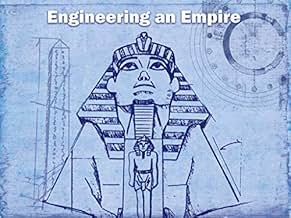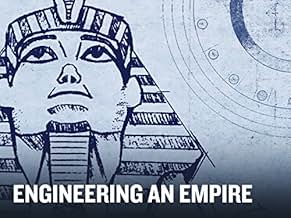अपनी भाषा में प्लॉट जोड़ेंA series of documentaries that go over the world's history and it's many accomplishments.A series of documentaries that go over the world's history and it's many accomplishments.A series of documentaries that go over the world's history and it's many accomplishments.
- 1 प्राइमटाइम एमी के लिए नामांकित
- कुल 1 नामांकन
एपिसोड ब्राउज़ करें
कहानी
क्या आपको पता है
- ट्रिवियाHost Peter Weller is a very apt choice for this series, as he is an academic art historian, with a Master's degree and a Ph.D. His specializations are Italian Renaissance Art and ancient Roman art, which would include close studies of ancient Greece and architecture.
फीचर्ड रिव्यू
Well, I suppose opinions may differ, but I thought this was a splendid series from the History Channel, both informative and entertaining.
It's not ONLY about engineering, which was great with me -- a non-engineer -- and it focuses on two or three of the more memorable structures or, more generally, engineering triumphs, in each episode.
These achievements aren't presented sui generis. Each is given a historical context, a reason for being. If Polycrates of Samos is at war and is afraid that his city may be isolated from its water supply, which is on the other side of a great mountain, he builds a tunnel through the mountain that slopes downward from the spring to the city. That's why he built this demoniacally complicated affair. And how did Polycrates do it? He did it by using high-school level plane geometry, that's how.
Peter Weller makes an occasional appearance on each site, although he's not the narrator. I admire Peter Weller a lot, not so much as an individual but as a type. He had an active career on the movie screen, not an outstanding one, and he could have lived off that. But, like Bob Cosby, his intellectual curiosity simultaneously led him in a different direction. He acquired academic credentials and now is a professor affiliated with Syracuse University. If I'd taken that job offer many years ago he'd have been my colleague and I'd have been proud of it.
I haven't seen all the episodes yet but I have the impression that a few details have been skipped or simplified. It's good to know that the Athenians lifted the pieces of each column of the Parthenon by means of cranes, but it would have been helpful if it had been explained that, with a pulleys, you lift a great weight with a lesser force by moving the free end of the pulley a greater distance. I'm not sure I've used the right terms here but the idea is simple enough to take only a minute to explain on the screen.
Anyway, there are reenactments of a sort. We see a few of the historical figures sweeping around the things they built. But none of it is pretentious. No CGIs of a thousand warriors clashing. No cast of thousands. Just a couple of people in period dress so we can put a name to the face.
Anyone with more intellectual curiosity than your average armadillo should find this interesting. I realize that leaves out a lot of people.
It's not ONLY about engineering, which was great with me -- a non-engineer -- and it focuses on two or three of the more memorable structures or, more generally, engineering triumphs, in each episode.
These achievements aren't presented sui generis. Each is given a historical context, a reason for being. If Polycrates of Samos is at war and is afraid that his city may be isolated from its water supply, which is on the other side of a great mountain, he builds a tunnel through the mountain that slopes downward from the spring to the city. That's why he built this demoniacally complicated affair. And how did Polycrates do it? He did it by using high-school level plane geometry, that's how.
Peter Weller makes an occasional appearance on each site, although he's not the narrator. I admire Peter Weller a lot, not so much as an individual but as a type. He had an active career on the movie screen, not an outstanding one, and he could have lived off that. But, like Bob Cosby, his intellectual curiosity simultaneously led him in a different direction. He acquired academic credentials and now is a professor affiliated with Syracuse University. If I'd taken that job offer many years ago he'd have been my colleague and I'd have been proud of it.
I haven't seen all the episodes yet but I have the impression that a few details have been skipped or simplified. It's good to know that the Athenians lifted the pieces of each column of the Parthenon by means of cranes, but it would have been helpful if it had been explained that, with a pulleys, you lift a great weight with a lesser force by moving the free end of the pulley a greater distance. I'm not sure I've used the right terms here but the idea is simple enough to take only a minute to explain on the screen.
Anyway, there are reenactments of a sort. We see a few of the historical figures sweeping around the things they built. But none of it is pretentious. No CGIs of a thousand warriors clashing. No cast of thousands. Just a couple of people in period dress so we can put a name to the face.
Anyone with more intellectual curiosity than your average armadillo should find this interesting. I realize that leaves out a lot of people.
- rmax304823
- 8 मार्च 2010
- परमालिंक
टॉप पसंद
रेटिंग देने के लिए साइन-इन करें और वैयक्तिकृत सुझावों के लिए वॉचलिस्ट करें
- How many seasons does Engineering an Empire have?Alexa द्वारा संचालित
विवरण
- चलने की अवधि44 मिनट
- रंग
- पक्ष अनुपात
- 1.78 : 1
इस पेज में योगदान दें
किसी बदलाव का सुझाव दें या अनुपलब्ध कॉन्टेंट जोड़ें










